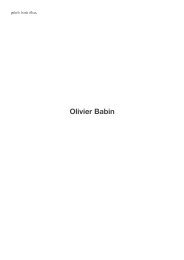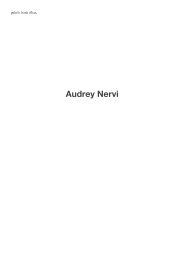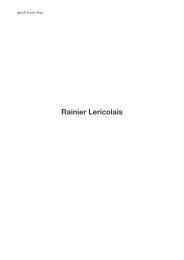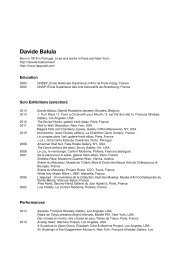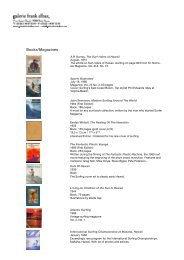Press book (english) - Galerie Frank Elbaz
Press book (english) - Galerie Frank Elbaz
Press book (english) - Galerie Frank Elbaz
Create successful ePaper yourself
Turn your PDF publications into a flip-book with our unique Google optimized e-Paper software.
Curated by Sophie Dannenmüller (catalogue available)<br />
<br />
Opening on Saturday, January 10th, 5-9pm<br />
Tuesday-Saturday 11am-7pm<br />
<br />
A legendary figure of the California Beat movement, Wallace Berman is generally remembered as unassuming,<br />
mystical and exceptionally charismatic. According to Dennis Hopper, "he affected and influenced everybody<br />
seriously involved in the arts in Los Angeles in the 50's. If there was a guru, he was it – the high priest, the holy<br />
man, the rabbi." Walters Hopps recalled "his magical touch of wit" – a magical touch still operating on younger<br />
generations who discover Berman's work today. For the first solo exhibition of the artist ever organized in France,<br />
the <strong>Galerie</strong> <strong>Frank</strong> <strong>Elbaz</strong> presents a selection of grids and "shuffles" from his pioneering copy art works, the <br />
.<br />
Berman started using the Verifax photocopier around 1964. It remained his main artistic tool until his accidental<br />
death in 1976. Given his fascination for the power of words, the name "Verifax", meaning something like "True<br />
Facts", must have held a symbolic significance. It recalls for instance the titles of earlier works, <br />
(1957) and (1952-57), featured at the Ferus Gallery in 1957 – a legendary show closed by the police<br />
on grounds of pornography. With the Verifax, Berman was able to fuse several mediums that had long interested<br />
him, i.e. photography, collage and printing. The two-step gelatin dye transfer process of the Verifax is very similar<br />
to that of photography, although entirely automated. The original to be copied was placed on the Verifax glass<br />
plate and photographed; a negative image of the original was produced and needed to be re-introduced in the<br />
machine, before being discarded, to allow the final positive copy to be printed.<br />
In the , Berman made extensive use of an image of a hand holding a transistor radio, taken from<br />
an advertisement for a small 1963 Sony transistor, probably found by chance in a magazine. Berman covered the<br />
text of the ad with white paint, retaining only the image, and then cut out the rectangular space of the speaker to<br />
replace it with various other images, found in the press or in <strong>book</strong>s. The artist worked directly on the Verifax plate,<br />
without creating an actual pasted down composition beforehand. In other word, there is no "original" collage in<br />
the ordinary sense: the of the ephemeral piece the original work of art. Berman experimented with<br />
the process, varying the required dosage of activator baths, as well as the development and exposure times. He<br />
also incorporated the negatives into finished works instead of disposing of them. Furthermore, the printed<br />
photocopies were usually not simply left in the form they came out: chemicals applied on the still wet paper<br />
produced degrees of highlights, shades of sepia, as well as spots and splashes that look like accidents. As a<br />
result, exactly identical "copies" of any one "original" were never obtained.<br />
After completing a series of single photocopies, actual collages were composed by gluing down on a board from<br />
4 to 56 different "hands", side by side in a square grid pattern or overlapping in a "shuffle". This is in fact the only<br />
time a real collage takes place, with visible joints between the fragments – this of course doesn't happen with<br />
photocopying, which neutralizes all of the colors, paper qualities, layers and junctions. The so-called <br />
(like today's digital art) are hardly collages in the sense of cutting and pasting materials to a surface, but<br />
rather disparate visual elements blended by a quasi-magical operation. The visuals resulting from the automated<br />
process, fortuitous incidents and controlled hands-on manipulations were many times removed from the images<br />
placed in the Verifax at the beginning of this creative routine, in which artist, chance, and machine alternately took<br />
the upper hand.<br />
Sophie Dannenmüller<br />
For more informations, please contact Daphné : +33 (0)1 48 87 50 04 / daphne@galeriefrankelbaz.com



